Name: …. Age: 11 years Sex: Male
Education: 5th standard Handedness: Right DOB: 16/02/2006
School: ……………………..
Informants: Parents and Self
Information: Reliable and adequate
Referred by: ……
Reason for Referral: For the assessment of current level of intellectual functioning and learning disability
Duration: Since four years of age
Chief Complaints:
• Poor academic performance
• Problems in reading
• Spelling errors
• Problems in pronunciation
History of Present Illness:
The client also reports that it is difficult for him to write, not because he doesn’t have information to elaborate on, but because he doesn’t know how to write a lot of words. He mentions that he gets confused with spellings and therefore, is unable to express in a clear manner.
The client also has a problem of mispronunciation, which has been present since his childhood (two years of age). Over the year multiple medical opinions were
Family history
The client lives in a nuclear family with his parents and younger sister. His father, 41 years old is a businessman and his mother, 35, is a homemaker. His sister, 10 years old will now start 5th standard.
The family environment is congenial; yet there are comparisons between the client and his younger sister, who scores above average in her class. The client does report feeling less favored by his father as compared to his sister. The client is attached to his mother the most in the family.
Consanguinity is absent between the parents and there is no history of psychiatric illness in the family.
Family genogram
 |
Personal history
Birth and Early Development
Childhood history
According to the informants, the client has always been very social and friendly. He is involved in various group activities with his friends. Although he is reported to be a little stubborn and aggressive at times, he has cordial relationships with his peers and his family. There is no history of stealing, sleep disorders, enuresis, encopresis, tics and unusual habits.
Scholastic History and Extracurricular activities
The client started formal schooling at the age of 4 years. He reports being interested in his studies, but feels that he can’t cope in the class with the pace of the teachers. He has been an average student throughout due to his ability to memorize the content, even when he doesn’t understand it. He is excellent in sports and reports an active interest in various games like cricket, basketball and cycling in school as well as with friends at home. He is also a keen artist and indulges in painting, drawing and model making for leisure.
Mental Status Examination:
The client was well
Tested On: Date and time
Tested in: Hindi and English
Test duration: 2 sessions – 4hours
Tests administered:
• Binet Kamat Test
• NIMHANS Battery for Learning Disability
Behavioral Observation:
Test Findings:
Binet Kamat Test for
On Binet Kamat Test for Intelligence, his basal age was found to be 10 years and terminal age was found to be 19 years. His Intelligence quotient came out to be 114, i.e.
NIMHANS assessment battery for Specific Learning Disability
On NIMHANS Assessment Battery for Specific Learning Disability, he had been tested
Reading and Comprehension
Assessment of reading ability was done by asking the child to read out a given passage. There was confusion between words like him/her, push/pull etc. A lot of letters were omitted and
Writing and Spellings
Arithmetic
In Arithmetic, he has a well formed concept of graded addition, subtraction, multiplication and division. He can do double digit
Summary of Findings:
The client’s IQ
On NIMHANS Index for Specific Learning Disability, the client was found to have disability in the areas of Reading, Writing and Spelling.
Impression:
Mixed Learning Disabilities (Reading, Writing and Spelling)
Suggestions:
• Child is eligible for Exemption Certificate and other benefits given by
• Parental counseling
• Assisted learning with the help of teachers/parents
• Exercises that increase phonological awareness, to help him to learn and understand sound patterns associated with words
• Using
• Using mnemonics and
• Pre-teaching vocabulary using analogies, synonyms or visual aids
•

